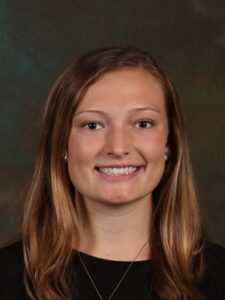Neuroscience students share research
By Shannon Sigafoos
Elaine Reynolds, professor of biology, along with colleagues at Lehigh Valley Society for Neuroscience (LVSfN), organized the virtual 2021 LVSfN Meeting attended by representatives from across Lehigh Valley Association of Independent Colleges (LVAIC) schools as well as Lycoming College and the College of New Jersey. Matt Wierzbicki ’21, Grace Guerin ’21, Madi Wahrmund ’22, Karla Carino ’22, and Maria Padilla ’22 each presented their research or thesis work, representing the labs of Reynolds; Lisa Gabel, chair of neuroscience; and Tamara Stawicki, assistant professor of neuroscience.
“While it is great for the students to participate in research, it is very important that research is communicated to other scientists through presentation and publication. These students not only worked hard in the laboratories to answer scientific questions but also completed their projects to the point where they had conclusions which they could present publicly,” said Reynolds. “The students have to know the background and their experiment very well to be able to stand up and talk about it. Even though the conference was virtual, the presentations themselves require a great deal of work, and the talks are practiced many times. It takes a lot of poise to do this kind of presentation in front of faculty and other students.”
Matt Weirzbicki ’21
Topic (Thesis): Acute Seizure’s Effects on Associative Memory in D. melanogaster

Matthew Weirzbicki ’21
About the presentation: “Fruit flies have been used as a model organism for epilepsy for decades, and we’ve employed a technique called optogenetics to cause seizures only in specific brain areas with nothing more than exposure to light. We measured how seizures in various regions impact flies’ ability to learn and remember, which is significant as about half of all people with epilepsy also have some degree of learning deficit.”
“Conferences held over Zoom have their own unique challenges and open the door to technical difficulties, but Professor Reynolds and her peers did a phenomenal job organizing this, and it was nice to hear from our peers from other institutions with similar passions for research. Opportunities like this to conduct and present research under a mentor like Professor Reynolds are one of the biggest benefits of Lafayette as a STEM student.”
Madi Wahrmund ’22
Topic: Observing Mitochondrial Number Differences in Drosophila melanogaster Bang-sensitive Mutants

Madi Wahrmund ’22
About the presentation: “This presentation was a mid-semester update on how my research is going and what I hope to accomplish in the coming months. I used epileptic fly models for my work and conducted biochemical assays to determine mitochondrial numbers in three different fly mutants and one non-mutant control under two different food sources. This research focuses on whether there is a quantitative difference in mitochondria between the different mutants and across two different experiment food types, knowing that flies show fewer seizures but a shortened life span under a yeast-sugar food.”
“I found presenting and participating virtually to be smooth. I enjoyed getting to listen to other presentations from students and gain this experience presenting my own work. I have to thank Professor Reynolds for putting on the conference even during a pandemic and for encouraging me to take part in it.”
Maria Padilla ’22
Topic: Measuring Mitochondrial Membrane Potential in (Zebrafish) Cilia Mutants with Mitotracker and JC-1

Maria Padilla ’22
About the presentation: “I decided to present this topic because my research professor, Dr. Stawicki, and I have been working on this project for two semesters. The results are good indicators for future routes we or others can take for this topic. The reason why it was important for the conference was to add value to the current project and those associated with it. By presenting those findings and future directions to our audience (other schools in the Lehigh Valley), we will be able to bridge our findings and theirs to prospective research we conduct when cilia mutants are involved.”
“Participating in this conference was undoubtedly a great opportunity to enhance my presentation skills and inform those present about the active field of research at Lafayette College.”
Grace Guerin ’21
Topic: ERK Cell Signaling Pathway and its Role in Aminoglycoside-Induced Hair Cell Death in the Zebrafish Lateral Line system

Grace Guerin ’21
“I hypothesized that the ERK pathway would contribute to hair cell death when exposed to neomycin, an aminoglycoside, so I treated half of the fish with an ERK inhibitor and the other half were used as a control. There was no significant difference in hair cell death between the two groups, so it is unlikely that the ERK inhibitor helps with hair cell death.”
“A greater understanding of how ERK functions in hair cells and in response to will allow us to better understand hair cell function and death as well as the ERK signaling pathway. I investigated ERK function in hair cells using the zebrafish lateral line system. We failed to see a noticeable difference in lateral line hair cell death between fish treated with neomycin and control fish. Additionally, we stained for pERK and failed to see noticeable staining in mature lateral line hair cells but did see staining in possible hair cell precursors and the lateral line nerve. The developmental role of ERK is currently being investigated, and future work will look at whether pERK is upregulated following aminoglycoside activity.”